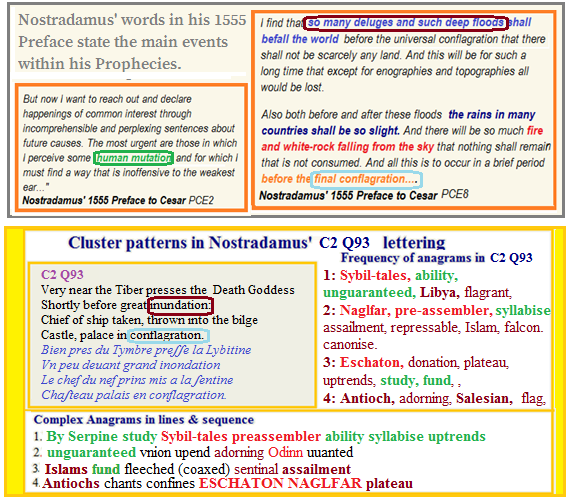 Analyses of all verses
Analyses of all verses
|
 Web Site
Web Site |
 All
Sefirots All
Sefirots |
Nostradamus C2 Q93: Ship of death signifies the End of Days for many in the 21stC
Copyright: Allan Webber, December 2015, 2022
This verse is highly significant in Nostradamus scheme since it ties his prophecies to the major topics he set out in his 1555 Preface as well as to the definitive statement in that work about the significance of the term mutation.
 The connections between verses and quotes, together
with modern topics uniting the anagrams in these verses, enables the
trail for floods to be followed through randomly inserted verses in a
way that removes the obscurities faced by earlier analysts. The
main verses involved in this flood based topic are
listed in pairs in the table alongside. I list them in pairs because
there is a natural fit of ideas using that style but they also form a
cohesive whole with cross-threads between the text and anagrams of all
verses in the group of ten.
The connections between verses and quotes, together
with modern topics uniting the anagrams in these verses, enables the
trail for floods to be followed through randomly inserted verses in a
way that removes the obscurities faced by earlier analysts. The
main verses involved in this flood based topic are
listed in pairs in the table alongside. I list them in pairs because
there is a natural fit of ideas using that style but they also form a
cohesive whole with cross-threads between the text and anagrams of all
verses in the group of ten.
This verse pairs with C1 Q15 because the text and anagrams of both verses pair with those holding the date mechanisms of the floods. That date involves the turning of the current Pole star (Ursa Minor) in 2105CE. It is implied in each of the sources via terms such as "before the final conflagration (in Preface)", "Naglfar Eschaton (C2 Q93 L4 anagrams)" and "century approaches its renewal (C1 Q16 l4 text)"
The term 'mutation' ties the
ties the period of the 21st century to the quotes Preface via verses
C1 Q51
and C1 Q54
which contain anagrams for that same term. That date is seen in these two verses as a result of the astronomic
settings given in them.
In each case where mutations is used it is apparent the topics are of
paramount importance to Nostradamus. In addition they are spelt in the
same way in both documents and Nostradamus uses them nowhere else.
That date is seen in these two verses as a result of the astronomic
settings given in them.
In each case where mutations is used it is apparent the topics are of
paramount importance to Nostradamus. In addition they are spelt in the
same way in both documents and Nostradamus uses them nowhere else.
For instance the fourth line of text in this verse talks of conflagration followed by a great inundation and this same combination is seen as part of the flood message in Nostradamus' Preface to Cesar 1555.
The topics dealing with HUMAN MUTATIONS are identified by Nostradamus as VAST FLOODS, FIRE IN THE SKY, CLIMATE EVENTS & A ONE-OFF FIERY WORLD SHATTERING EPISODE.
The fourth line of C2 Q93 also contains two critical anagrams, Eschaton (onChaste) and Naglfar (nflagra). There are only two other anagrams for Eschaton in the whole text and only one other for Naglfar. The word eschaton is an End-of-Days term while Naglfar refers to the ship that is involved in the Nordic End-of-Days mythology.
Naglfar is discussed in stanza 49 and 50 of the Norse poem Voluspa of the Poetic Edda and from this source we can get a strong image of Naglfar as one of many creatures and horrors let loose by the flood and the proponents of war.
Naglfar is described in the Prose Edda as a ship made entirely from the fingernails and toenails of the dead. During Ragnarok, Naglfar will be freed from the land and sailed to Vigridr, the battlefield, by Hrym along with an army of jotunn. The ship will lead hordes against the gods in the last war at the end of time, before a new world will arise from the sea. These are the images Nostradamus has incorporated in the above verse where we have the inundation similar to that of the Nordic End-of-Time and we have a ship which is linked to the Goddess of Death. All of which is enough to show that Nostradamus was drawing on a pagan source for another dimension to his tale of future floods
Hrym steers from the east, the waters rise, the mundane snake is coiled in jotun-rage.
The worm beats the water, and the eagle screams: the pale of beak tears carcases; Naglfar is loosed.
That ship fares from the east: come will Muspell's people o'er the sea, and Loki steers. The monster's kin goes all with the wolf; with them the brother is of Byleist on their course. ....Wikipedia entry
There are also further anagrams of Eddic relevance. These are Odinn and Sybils-tale, the latter of which gives the christianised version of the End-of-Days event.